

| Home | For sale | Site map | Contact information | Guest book | Lafette-menu |
 The
Überschießtafel The
Überschießtafel  |
|---|
Background check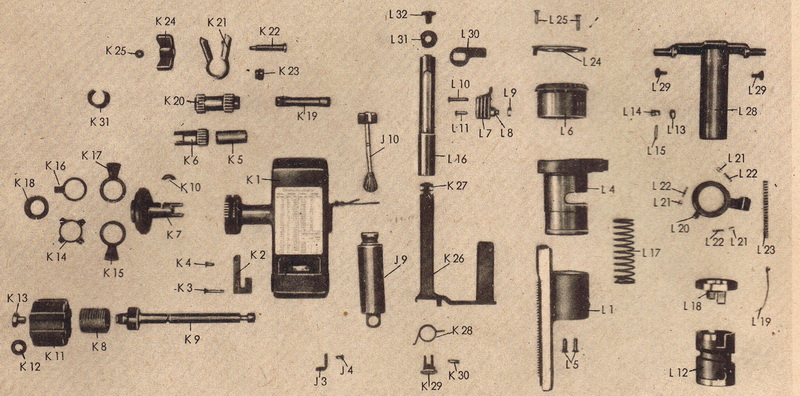 As we have seen earlier, the Lafette 34 was a rather complex piece of machinery. And the absolutely most complex piece of the Lafette was the searchfire mechanism, the "Richt- und Tiefenfeuereinrichtung". In this article I will only focus on the Overhead firing table, the "Überschießtafel" (the strange letter "ß" equals a double "s" in written german). This table was riveted to the rear body of the searchfire mechanism from the very start of production until the very end of it. I will not go into details in regards to the use of it, but will merely discuss the physical item. All of my conclusions have been based on the study of surviving examples, as I have had no access to any written documentation about the Tafel. 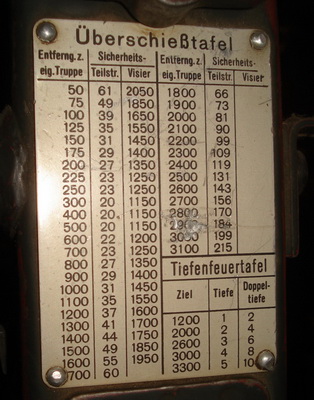 The "Überschießtafel" was riveted to the body of the searchfire mechanism with an aluminum rivet in each corner. The non-magnetic rivets stayed in use from the very start of the production of the Lafette and at least until the end of 1944. A few makers have also used steel rivets from 1943 and onwards, but these are very scarce compared to the aluminum ones.  The rivets had a perfectly doomed head, both inside and out. The housing containing the searchfire mechanism was first painted, and then the "Überschießtafel" was riveted on. After that, the mechanism was assembled. Due to this, only the two lower internal rivets are visible (or accessible) on the rear, the upper two are covered by the mechanism. 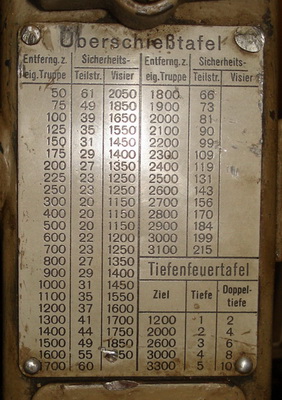 As the rivets are made of aluminum, they are prone to get damaged. In the picture above, the two lower rivets are undamaged, while the upper two appear to be damaged and possibly repaired. Most of the time deformed rivet heads would still be functional. First model The first model was used from 1936 to 1941.  This "Überschießtafel" belongs to an Excelsior Lafette (fsu) dated 1937. This is the first model, made of aluminum with a matt coating.  This can clearly be seen where the coating has been worn away due to the use of the wingnut for the brake, and in all the spots where the Tafel has been damaged. 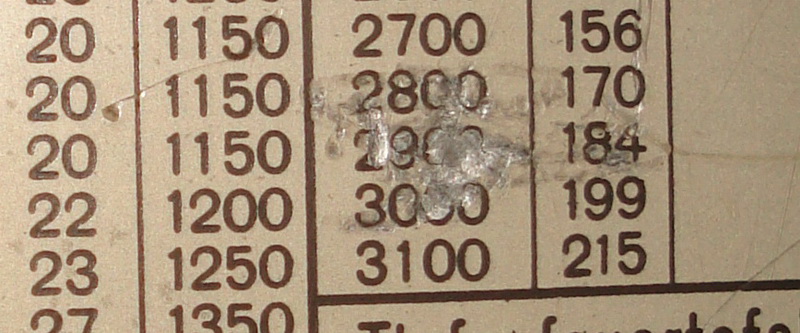 The above picture shows the matt silver coating in contrast to the bright aluminum the table was made of, clearly visible in the damaged areas.  The first model came in two versions. They are identical, with the exception of the design of the heading. The heading varies in length and font-size, and the design of the first letter, the "Ü". The "short text" version was only used by the manufacturer Linden & Funke KG, Iserlohn, maker-codes 736, axx and YV. Second model The second model appears on production Lafettes in 1941, and gradually replaced the first model. The second model was made of Celluloid. Celluloids are considered the first thermoplastic, created from nitrocellulose and camphor. Celluloid is easily molded and shaped, and still used in the production of table tennis balls. 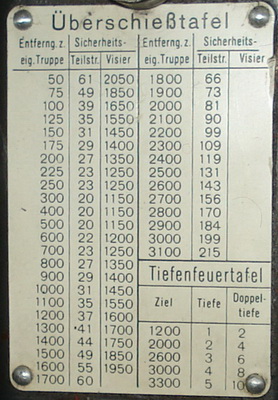 The table was white with black lines and text printed/etched on. It can sometimes be difficult to tell the first and second model apart just by looking, as well-used tables take on grime and dirt, and becomes yellowish with age. Looking at damaged areas will tell them apart, as the silvery aluminum core will shine through on the first model, while damaged areas on the second model remain white.  The design of the table was almost identical between the first model (first version, left) and the second model (right).  The only visible difference between the two models is the line inside the red circle above. On the first model there will always be a gap, while on the second model it will always connect with the vertical line. Second model, transitional version 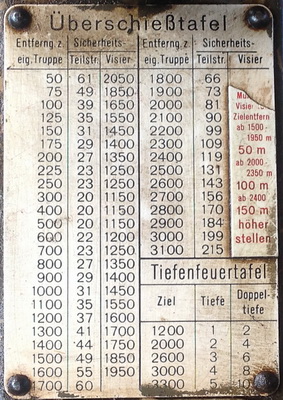 The above Lafette is a dar 1944. The second model was issued in a modified version in 1943. A new text with additional adjustment instructions in red was added on a separate piece of Celluloid. This piece was glued on over the blank square. This version is quite rare; I have only seen a handful examples over the years. The two examples pictured here are both used on Lafettes manufactured by Metallindustrie Schönebeck A.G. code dar.  The above Lafette is a dar PJ (1944). Note the use of steel rivets that have rusted over the years. Third model The third model was issued in 1944. 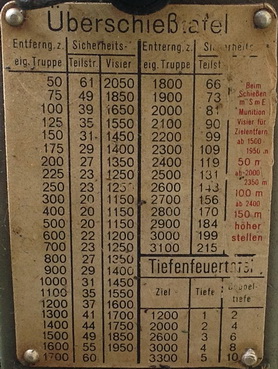 The red text with additional adjustment instructions was now printed/etched directly to the Überschießtafel. The second and third model is again identical, apart from two exceptions.  First of all the addition of the red text of course, and secondly the word "Visier" and the line below it has been removed. 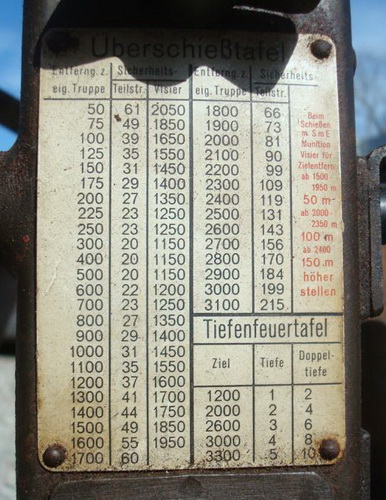 The third version was used until the production of Lafettes ended in 1945. A strange model 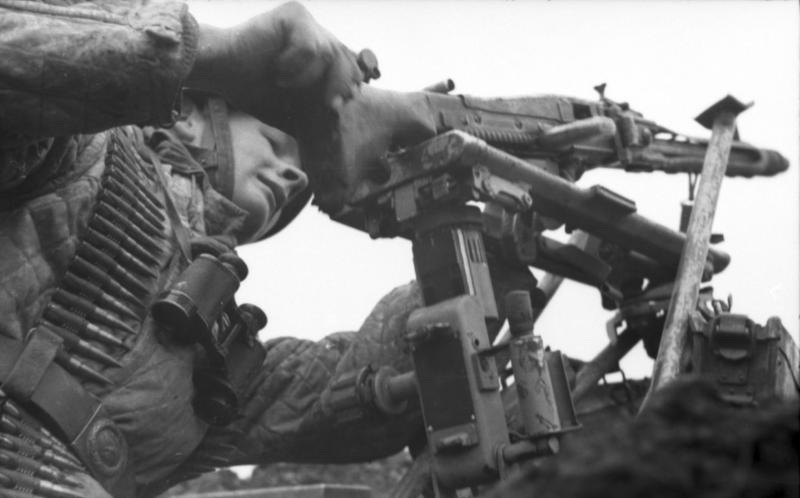 This picture shows a Fallschirmjäger mounting his MG42 on a Lafette 42. The location is Monte Cassino, Italy in 1943/1944. It had me scratching my head, as I have never seen a black "Überschießtafel". Further studies disclosed the truth though. The Lafette 42 is an early example, in factory applied Dunkelgrau. It had later been field-painted Dunkelgelb, and then the Celluloid "Überschießtafel" got damaged / was removed / got lost. It isn't there anymore. It is just an optical illusion, as the rivet's shiny heads are still there, and the factory applied Dunkelgrau behind the Tafel is now visible. The oil brush in the trigger handle has also gone missing, and has been replaced with a wine bottle cork. Other models Both wartime and postwar users from other nationalities used the Lafettes. Some needed to replace the original "Überschießtafel" with copies in their own language, while other users just continued to use the Lafette with the original "Überschießtafel". 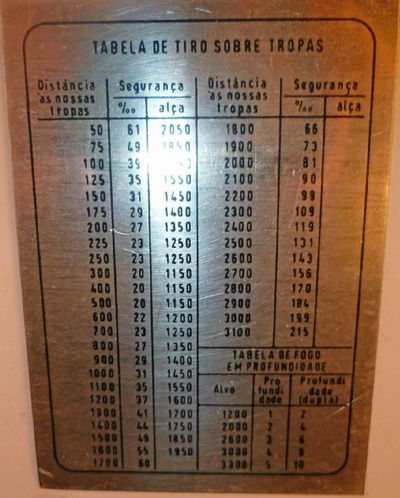 The Portuguese war time version, used on the batch of Lafettes imported to Portugal in 1943/44. Today very rare, as they were removed postwar from the Lafettes by the buyers. 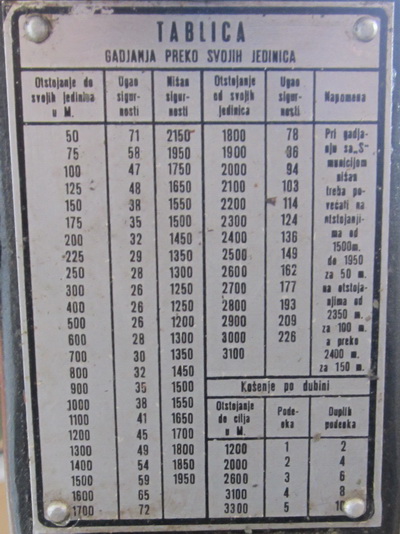 The Yugoslavian postwar copy. The numbers are slightly off, compared with the original German "Überschießtafel". Probably corrected for their MG53 with Yugoslavian ammunition. 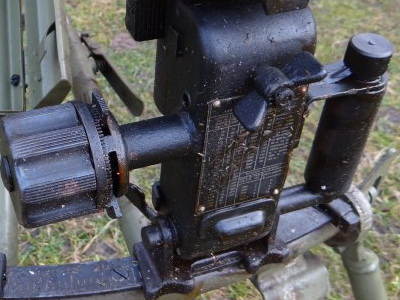 The Yugoslavians also made a black version. Modern copies With the ex-Portuguese Lafettes, the Lafettes used by Yugoslavia and original Lafettes that had lost the "Überschiesßtafel", the need for a "replacement Überschießtafel" brought about an array of copies. Copies of the first model 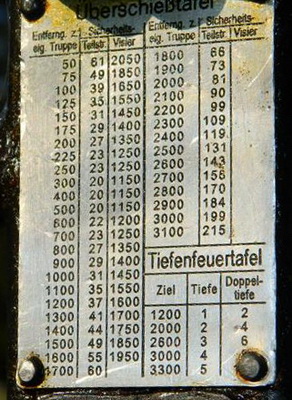 Aluminum, originally used from 1936 to 1941. This is probably the model that is hardest to fake, as the matt coating is hard to reproduce. Also worth noting is the fact that the specimen above lacks the "space" between the horizontal and vertical lines, as described earlier. Copies of the second model 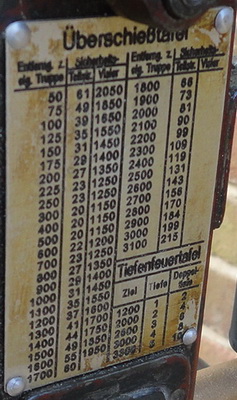 Celluloid, originally used from 1941 to 1943. Modern copies made from white plastic, so close in resemblance they would be hard to tell apart when it comes to the materials. The second model would be the one easiest to reproduce, but is actually quite rare. The one pictured above again fails on the missing "space" between the horizontal and vertical lines. The first "connection point" is correct, but the two next crossings shouldn't be touching. The lines over and under "Tiefenfeuertafel" should run all out to the edge. It is also easy to tell that the rivets haven't been there for 70 years. Also worth noting is the location of the rivets (too far out towards the edges), the much too large rivet heads and the fake weathering effect applied to the white plastic. I have never seen any copies of the revised second model. Copies of the third model The third model was made from Celluloid, and was originally used from 1943 to 1945.  The first fake version to be discussed is pictured above. It was made from aluminum, and is of course way off the grid. 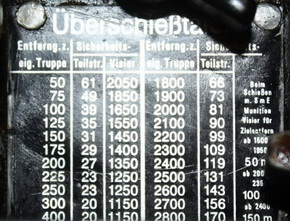 The second fake version. Again the wrong use of materials. Aluminum instead of Celluloid. This one has also got the colors inverted, with silver text on a black background. Pure fantasy. 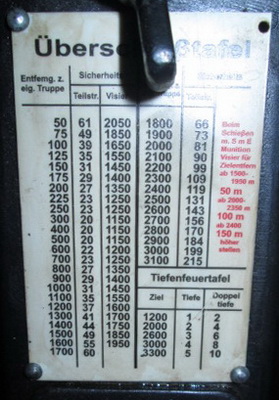 The third fake version. A fair attempt. Colors and materials are both right. This one is spoiled by the use of wrong font sizes, a heading in bold, badly placed rivet holes (due to wrong size of the whole table), pointy corners and overall miss-proportions. Note the blank area at the bottom and top. On the original the heading is on line with the rivet heads.  The fourth fake version. This table has got the internal layout mostly right, but the whole contents of the table is much too small, again leaving large blank spaces on top, bottom and also on the sides. The red text is much too bleak and small. Nice rivets though! 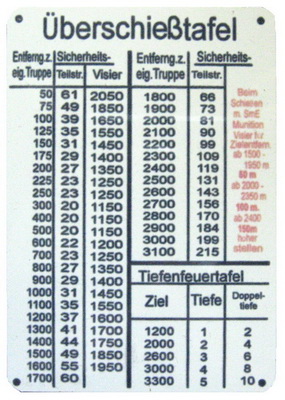 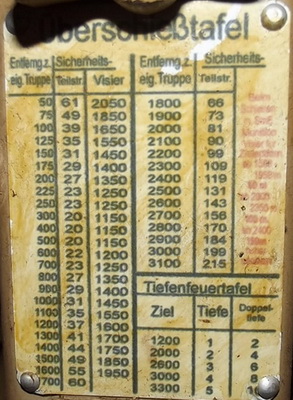 The fifth fake version. The left picture above shows it "factory fresh" and the right picture as mounted and with artificial weathering applied. By far the best in regards to proportions. But the red text is much too bleak; the "Tiefenfeuertafel" text should have been centered and placed higher. The "ß" in the "Überschießtafel" appears to have been drawn by hand. And again the rivets' locations are not good. 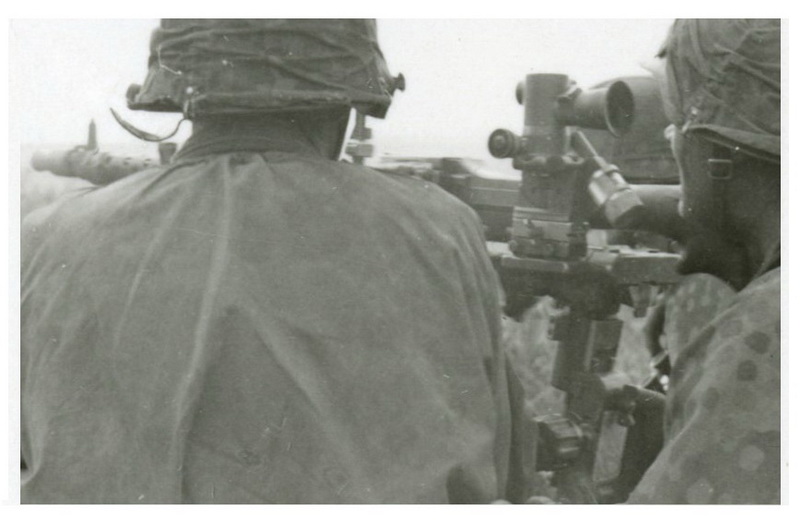 There might be more versions of fake tables out there, and more and better is surely to come. To win the battle, you must arm yourself with the knowledge of what the originals looks like! |
| Home | For sale | Site map | Contact information | Guest book | Lafette-menu |